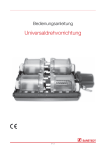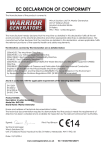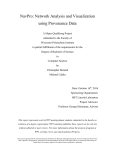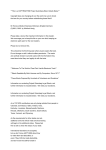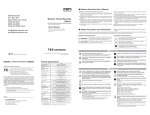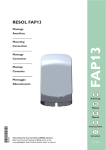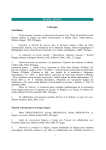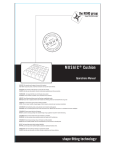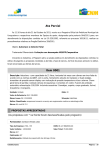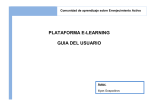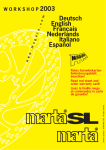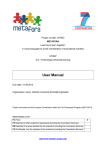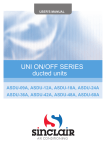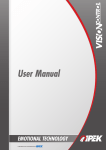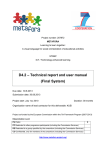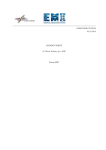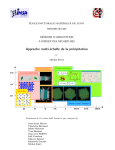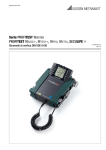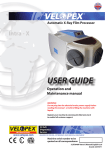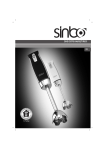Download GB 135_miniPERM.indd
Transcript
User Manual
miniPERM®
User Manual - miniPERM®
User Manual - miniPERM®
Contents
Introduction ......................................................................................................................................................26
Design and function of the miniPERM® bioreactor
Operating instructions.......................................................................................................................................28
Example of hybridoma cell culture
High density cell culture in the miniPERM® bioreactor .......................................................................................34
High density cell culture
Oxygen requirement of hybridoma cells
Production rate
Changing the medium
Handling of the miniPERM® bioreactor
Troubleshooting ................................................................................................................................................35
Problems and solutions
Literature ..........................................................................................................................................................39
Publications and application notes
Accessories ......................................................................................................................................................40
Ordering information .........................................................................................................................................41
Brief instruction manual ....................................................................................................................................42
24
25
User Manual - miniPERM®
1. Introduction
Design of the miniPERM® bioreactor
miniPERM® is a bioreactor made of two connected
modules designed for the cell culture of hybridoma
and other cells in high densities (“high density culture”).
It consists of:
s a disposable production module which serves as a
culture chamber with a volume of 35 ml or 50 ml
(miniPERM® classic or HDC 50); and
s an autoclavable, reusable or sterile disposable
nutrient module made of plastic (polycarbonate)
which serves as a media reservoir with 550 ml
volume that is attached to the production module.
To separate the two modules, the production module
is fitted with a semi-permeable dialysis membrane
(MWCO 12.5 kDa) on the side facing the nutrient module, when the two modules are connected.
The outer part of the production module is made of a
thin, gas-permeable silicone membrane.
The screw cap of the nutrient module has an integrated gas-exchange membrane.
User Manual - miniPERM®
Function of the miniPERM® bioreactor
1. Dialysis membrane
Neither the cells nor high molecular weight products
released by the cells, e.g. secreted monoclonal antibodies, can pass through the semi-permeable dialysis
membrane.
However, nutrients (glucose, amino acids), vitamins,
ions, and gases (O2, CO2) dissolved in the medium can
diffuse from the nutrient module into the production
module. Due to more than a 10 fold excess of nutrient
medium, the cells are provided with substances
necessary for cultivation over a long period of time.
Simultaneously, acidic (e.g. lactic acid), toxic (e.g. ammonium ions) and other low molecular mass products
of the cell metabolism diffuse from the production
module through the dialysis membrane into the
nutrient module where they are diluted and neutralised
in the large excess of medium.
2. Silicone membrane
Oxygen requirements are fulfilled by O2 diffusing from
the incubator atmosphere into the production module
through the silicone membrane. The CO2 produced
by the cells in corresponding quantities leaves the
production module via the same route. The high CO2
permeability of the silicone membrane in the production
module means the NaHCO3 in the medium is at
equilibrium with the CO2 in the incubator atmosphere.
3. Screw cap with gas-exchange membrane
The gas-exchange membrane in the screw cap of
the nutrient module enables equilibration of pressure
between the bioreactor and the outer environment.
4. Universal Turning Device
For optimal supply of nutrients and removal of
metabolic waste products through the membranes,
cells and the medium must be circulated continuously.
Therefore, the miniPERM® bioreactor is rolled in a
Universal Turning Device during cultivation.
Due to the exceptionally high cell densities produced
in the miniPERM®, a higher than usual turning speed
is required. For this reason, we recommended the use
of the Universal Turning Device which can rotate the
miniPERM® from 0.1 to 40 rpm compared to standard
turners that usually have a maximum speed of
2.5 rpm.
The discharge of CO2 from the miniPERM® is further
promoted by the fact that CO2 (dissolved in the culture
medium both physically and in the form of NaHCO3)
can pass through the dialysis membrane from the
production module to the nutrient module.
Nutrient module
Production module
Cell product
Glucose
silicone sealing ring
nutrient
module
Lactate
support grid
NH4+
dialysis
membrane
production
module
CO2
Cell
silicone
membrane
frame
srew caps
srew cap with integrated
gas-exchange
membrane
nutrient module
26
O2
Silicone membrane
Dialysis membrane
Universal Turning Device
The dialysis membrane is covered with a support grid
facing the nutrient module. This grid has two functions:
115 / 230 V
It protects the dialysis membrane from mechanical
damage, and provides a means of swirling the nutrient medium at the dialysis membrane surface leading
to an improved diffusion of nutrients and metabolic
products.
27
User Manual - miniPERM®
User Manual - miniPERM®
Operating Instruction
All the operations
described below
must be carried out
in a sterile hood!
Cells are cultivated
under normal laboratory
conditions, centrifuged and
adjusted to the specified
density.
Ensure the clips
of the production
module are
completely snapped!
It is very important
that the nutrient
module is autoclaved
to a maximum of 121°C
and no more than 10
times. Higher temperatures
lead to deformation of the
polycarbonate.
Before connecting
the two modules,
unscrew the screw
cap of the nutrient module
(to prevent pressure buildup)!
Ensure the clips
of the production
module are
completely snapped!
1. Preparation of cells for culturing in the
miniPERM® bioreactor using hybridoma
cells as example
The miniPERM® classic culture can be started with
about 35 to 37 ml of a cell suspension containing
approximately 1 to 5 x 106 cells/ml (35 to 185 x 106
cells total) (fig. 1). In most cases, the contents of 1 to
2 well grown 150 cm2 cell culture flasks are sufficient
for this purpose.
1
For using the miniPERM® HDC 50 production
module the cell suspension contains
1 to 5 x 106 cells/ml in 50 ml.
2. Preparation of the miniPERM® bioreactor
2.1 Pre-assembled miniPERM® sterile
In this version, the miniPERM® has been assembled
from the two modules and sterilized. This represents
a single-use product. It is not autoclavable. It can be
used without further treatment (fig. 2).
2.2 Multiple-use miniPERM®
The production modules are supplied as disposables
in an alu pouch. The reusable nutrient module must
be sterilized by autoclaving to a maximum of 121°C
prior to use.
s0ACKTHENUTRIENTMODULEINANAUTOCLAVINGBAG
(fig.3) and autoclave it without the screw cap for
20 min to a maximum of 121°C (also refer to
item 7).
s 4HEALUPOUCHOFTHEPRODUCTIONMODULEISOPENED
to ensure the production module is resting on
the screw caps of the Luer Lock-connectors.
The production module should be left in the
plastic pack!
s 4HEAUTOCLAVEDNUTRIENTMODULEISNOWPUSHED
against the sealing ring of the production module
(figs. 4 and 4a) until the snapper clips of the
production module are snapped audibly into the
indentations on the rim of the nutrient module.
s 4HEPLASTICPACKOFTHEPRODUCTIONMODULECAN
now be removed.
s 4HEASSEMBLEDMINI0%2-® is now ready for use.
2
When the cell
suspension is
introduced the air
displaced by the medium
must be released through
one of the other ports!
Therefore, a second screw
cap should be loosened.
1,2 bar
121°C/250°F
20 min
3
4
Medium at the rim
of the filling port
must be thoroughly
removed (by drawing up
with an exhauster before
closing the port).
3. Filling the miniPERM® bioreactor
3.1 Introducing the cell suspension into the
production module
The cell suspension is introduced into the production
module with a syringe through one of the three ports
equipped with Luer Lock connectors:
s -OUNTTHEMINI0%2-® bioreactor on the stand
with the production module on top so that one of
the three Luer Lock connectors is positioned at
the highest point (fig. 5).
s $RAWUPTHEPREPAREDCELLSUSPENSION
or 50 ml) through a sterile filling tube (5”) using a
disposable syringe () 50 ml). Remove air bubbles
from the syringe before injecting the cell
suspension (fig. 6).
s 2EMOVETHESCREWCAPATTHEUPPERMOSTPOINT!
Screw the syringe (without the filling tube) onto the
Luer Lock connector (fig. 7).
s 4URNTHEMINI0%2-® bioreactor so that one of the
other screw caps is positioned at the highest
point.
s ,OOSENASECONDSCREWCAPATTHEUPPERMOST
point (C). Inject the cell suspension slowly into the
production module (fig. 8).
s #LOSETHE,UER,OCKCONNECTOROFTHEPORTAT
position C tightly with a screw cap (fig. 9).
s 4URNTHEMINI0%2-® bioreactor back so that the
port (A) to which the syringe has been attached is
positioned at the uppermost point again (fig. 10).
s 2EMOVETHESYRINGE!IRBUBBLESSHOULDBE
removed by pressing the silicone membrane.
s #LOSETHEPRODUCTIONMODULEBYTIGHTLYSCREWING
a screw cap or a septum cap (see Troubleshooting)
onto the Luer Lock connector of the third port in
position A (fig. 11).
5
6
7
8
9
10
4a
11
28
29
User Manual - miniPERM®
Do not fill more
than 400 ml
into the nutrient
module. An air space
must be maintained above
the nutrient medium for
successful cultivation.
The rolling speed
must be selected
according to the
robustness of the cells, e.g.
sMURINEHYBRIDOMACELLS
5 to 20 rpm
sHUMANHYBRIDOMAAND
transfected cells:
2 to 10 rpm
Since the diameter
of the miniPERM®
bioreactor is twice
the size of the rolls of the
Universal Turning Device,
miniPERM® rotates at half
the set speed.
3.2 Introducing the medium into the nutrient
module
The nutrient module is filled with medium through the
large neck opening which is fitted with a screw cap
as follows:
s2EMOVETHESCREWCAPFROMTHENECKOPENINGOF
the nutrient module and pour in 350 to 400 ml of
tempered nutrient medium (fig. 12).
s4OREMOVEPRESSUREINTHEMINI0%2-® bioreactor,
press your hand against the silicone membrane of
the production module (fig. 13).
s#LOSETHENECKOPENINGWITHTHESCREWCAP
Tighten the screw cap applying a slight pressure
only.
s0LACETHEMINI0%2-® bioreactor onto the Universal
Turning Device and set the speed at the Control
Unit on 0.1 to 40 rpm.
User Manual - miniPERM®
350 to 400 ml medium
12
Under no
circumstances
should the screw
caps of the three Luer
Lock connectors of the
production module be
opened when the silicone
membrane is extended!
The excess pressure in
the nutrient module would
cause the cell suspension
to spurt out and be lost.
In addition, the outside of
the miniPERM® bioreactor
would be contaminated.
13
14
The above rolling
speeds refer to
the display on
the Control Unit.
miniPERM® actually
rotates at half this
speed.
Should foam
accumulate in the
production module
which is often the case
when FCS is used as a
medium supplement, it is
difficult to loosen the screw
cap of the production
module without getting foam
into the thread. To solve
this problem, an antiFOAM®
agent can be used in
the nutrient module (see
Troubleshooting).
4. Taking samples
4.1 Taking samples through a port of the
production module
s0LACETHEMINI0%2-® bioreactor in a sterile hood.
s%NSURETHATPRESSUREISRELEASED(OLDTHE
miniPERM® bioreactor with one hand applying
light pressure to the silicone membrane. With
the other hand loosen (do not unscrew) the screw
cap of the nutrient module, so excess pressure is
released (see figs.15/15a). Close tightly again.
s0OSITIONTHEMINI0%2-® bioreactor on the stand
so that one of the ports of the production module
is at the highest point (A) and remove the screw
cap of this connector (fig. 16).
s&ITASYRINGEOFSUITABLESIZEAPPROXML
depending on the sample volume to be taken) onto
the Luer Lock connector in position A (fig. 17).
s4URNTHEMINI0%2-® bioreactor so that the
sampling port (A) with the attached syringe
is positioned below the level of the liquid in the
production module (fig. 17). Draw up the sample
into the syringe.
s"EFOREREMOVINGTHESYRINGEMINI0%2-®
bioreactor must be turned so that the sampling
port with the attached syringe is positioned at the
uppermost point (fig. 18).
s!FTERREMOVINGTHESYRINGEAIRBUBBLESSHOULDBE
removed by pressing the silicone membrane with
the fingers.
s#LOSETHE,UER,OCKCONNECTOROFTHESAMPLING
port with a sterile screw cap (fig. 19) and return
the miniPERM® bioreactor to the incubator.
3/4
15
3/4
15a
16
17
Medium at the rim
of the harvest port
must be thoroughly
removed (by drawing up
with an exhauster) before
closing the port.
18
19
30
31
User Manual - miniPERM®
Small diameter
needles (25G x 5/8”)
should be used in
order to retain the sterile
barrier. The septum caps
should be replaced after
they have been pierced 5 or
6 times.
Harvesting must be
quick to prevent the
cells from settling
and clumping.
Medium at the rim
of the harvest port
must be thoroughly
removed (by drawing up
with an exhauster)!
32
4.2 Taking samples through a septum
One of the three ports can be replaced with a
septum cap which maintains the sterile barrier for
sample removal.
s0REPARETHEMINI0%2-® bioreactor as described in
4.1.
s#LEANTHEHOLEOFTHESEPTUMCAPWITHAPAD
soaked in 70% pharmaceutical ethanol.
s0IERCEASTERILENEEDLEWITHSYRINGE) 5 ml) in the
hole of the septum cap.
s4URNTHEMINI0%2-® bioreactor so that the
septum cap with the attached syringe is
positioned below the level of the liquid in the
production module (fig. 21).
s$RAWTHESAMPLEINTOTHESYRINGE
s2EMOVETHENEEDLEFROMTHESEPTUMCAP
s#LEANTHEHOLEOFTHESEPTUMCAPWITHASTERILE
pad soaked in 70% pharmaceutical ethanol.
5. Harvesting
The interval and volume of harvesting depend on
the cell density and the amount of product which
the cells produce. Once or twice a week on an
average, 2/3 of supernatant is harvested. Harvesting
is done essentially the same way as sampling.
s0REPARETHEMINI0%2-® bioreactor as described in
4.1.
s)NORDERTOPREVENTANEGATIVEPRESSUREINTHE
production module whilst drawing up the harvest
with a syringe, it is necessary to loosen a second
screw cap at position B (fig. 22).
s$RAWTHEHARVESTINTOSYRINGE
s#LOSETHESECONDPORT"WITHASTERILESCREWCAP
s4URNTHEBIOREACTORSOTHATTHEHARVESTINGPORT!
with the attached syringe is positioned at the
uppermost point and remove the syringe.
s4HEVOLUMEEXTRACTEDSHOULDBEREPLACEDBYFRESH
medium, see 3.1.
Depending on the cell density reached the
harvested cells could be resuspended in fresh
media and reinjected into the production module.
User Manual - miniPERM®
Cleanliness is of
utmost importance
when changing the
medium.
20
Risk of
contamination!
Care must be taken
to ensure that no traces of
the medium have been left
on the thread of the filling
port or run down the sides
of the nutrient module.
Should this occur, remove
via an exhauster or with a
sterile pad soaked with 70%
pharmaceutical ethanol. Do
not flame.
6. Changing the medium in the nutrient module
Replacing the spent medium with fresh medium
follows the same procedure as described in 3.2 for
the first filling of the nutrient module.
s0LACETHEMINI0%2-® in a sterile hood.
s5NSCREWTHESCREWCAPOFTHENECKOPENINGON
the nutrient module.
s0OURTHEUSEDMEDIUMINTOADISINFECTEDWASTE
bottle (fig. 23).
s&ILLTOMLOFFRESHTEMPEREDª#
medium into the nutrient module (fig. 24).
s2EMOVEPRESSUREINTHEMINI0%2-® following the
same procedure as described in 3.2 for pressure
equilibration.
s#LOSETHENECKOPENINGWITHASTERILESCREWCAP
Tighten the screw cap applying a slight pressure
only.
23
21
For disinfectants of
the screw cap do not
use ethanol, propanol
or disinfectants/solvents that
contain alcohol as their use
will impair function of the
PTFE membrane. Rinse with
distilled water only.
The reusable screw cap can
be autoclaved for 20 min to
a maximum of 121°C at least
5 times without change to
the material.
22
For disinfection
use only 70%
pharmaceutical grade
ethanol or isopropanol for the
miniPERM® bioreactor, the
Universal Turning Device, the
incubator and water bath.
All other chemicals,
especially quaternary
ammonium complexes may
cause microcracks.
Do not use n-propanol!
7. Cleaning and sterilisation of the nutrient module
(multiple-use nutrient module)
The reusable nutrient module can be autoclaved at
least ten times without changes to the material. To
avoid damage to the polycarbonate, the nutrient
module should be placed freely, i.e. not subjected to
pressure in the autoclave. The maximum autoclave
temperature is 121°C.
s4HEMODULESARESEPARATEDATTHEENDOFTHE
culture, using the hook end of the opener
provided, to gently prise open the snapper clips.
The production module can then be easily
removed from the nutrient module (fig. 25).
s#LEANTHENUTRIENTMODULEONLYWITHHOTWATER
and neutral or weak acid or alkaline detergent
without rinsing agents. Rinse with ample water
to completely remove the detergent. Do not use
an automatic dish washer.
s!UTOCLAVETHENUTRIENTMODULEWITHOUTTHESCREW
cap for 20 min, to a maximum of 121°C. Do
not use any alkaline-based corrosion protector in
autoclave boiler water.
350 to 400 ml medium
24
25
8. Cleaning the Universal Turning Device
The Universal Turning Device can be disinfected
with a cloth soaked in 70% pharmaceutical grade
ethanol or isopropanol. Do not use n-propanol. Do
not autoclave the Universal Turning Device.
33
User Manual - miniPERM®
High density cell culture in miniPERM®
'High density cell culture'
The design of the miniPERM® bioreactor makes it
possible to culture cells to considerably higher densities
('high density cell culture') than in conventional stationary
culture in which the oxygenation of the cells can
only be achieved via gas exchange through the cap.
Consequently, the cellular products are secreted in much
higher concentrations compared to conventional cultures.
Cells cultured in high density are very much dependent on
optimal culture, so they are more sensitive to disturbances
than cells in conventional stationary culture at densities of
105 to 106 cells/ml.
Due to the high density (107 cells/ml and greater) the
cells are dependent on the continuous supply of large
quantities of nutrients and oxygen and on the removal of
metabolic waste products and CO2.
Oxygen requirement of hybridoma cells
The oxygen consumption rate of hybridoma cells is in the
order of 5μg per 106 cells per hour.
With a cell density of 107 cells/ml, (which is easily attainable
in the miniPERM® bioreactor), the oxygen requirement
of the 35 x 107 cells cultivated in the 35 ml (miniPERM®
classic) of the production module is approximately
1.75 mg/hour.
Production rate
To produce a certain amount of product (monoclonal
antibodies in the case of hybridoma cells), a certain
number of cells are needed. The number of cells required
depends on the individual properties of the cells cultured.
According to Fazekas de St. Groth (J. Immunol. Methods
57, 1983, 121) hybridoma cells typically produce between
4 x 107 and 7 x 108 antibody molecules per cell in a
24-hour period.
Changing medium
The stressful conditions of high density cell culture means
the cells require a medium of particularly high quality with
respect to the content of glucose and NaHCO3. The
content of glucose should not be less than 4 g/l. If less,
the medium should be supplemented with additional
glucose. Most media have an NaHCO3 content (DMEM
3.78 g/l) which ensures a buffer capacity up to 2 weeks.
Due to the optimal gas exchange in the miniPERM®
bioreactor and the high cell density the initial glucose
content would be exhausted before the pH colour change
of the nutrient medium is indicated from red to yellow.
Thus, the buffer capacity of the medium to neutralize and
to buffer metabolic waste products is exhausted.
34
User Manual - miniPERM®
Troubleshooting
The interval of the medium change depends on the cell
line, the medium and the increase of the cell density. We
suggest 1 to 2 times per week. An orange-yellow colour
of the medium in the production module is indicative of a
high cell density (> 107 cells/ml).
Handling of the miniPERM® bioreactor
The temperature of the nutrient medium should always
be brought to 37°C before the module is filled. After
miniPERM® is filled with nutrient medium and introduced
to the incubator, the air above the medium heats and
expands. This expansion can be substantial: per 1°C in
temperature the increase in volume is 1/273 of the volume
at 0°C. Thus, the volume increases by about 24 ml if
the temperature in the space above the medium in the
nutrient module rises from 4°C to 37°C. This increase in
volume would cause a substantial rise in pressure (more
than 0.1 bar) in the nutrient module of the miniPERM®.
This would lead to expansion of the silicone membrane of
the production module.
There is another effect typical for cultures with NaHCO3buffered media in a closed bioreactor which causes a
further rise of pressure in the nutrient module. When a
culture is started, there is usually atmospheric air rather
than the CO2 containing incubator atmosphere in the
air space above the medium of the nutrient module.
Therefore, the NaHCO3 in the medium decomposes, and
the CO2 is released into the space above the medium of
the nutrient module. The result is a further rise in pressure
in the nutrient module and alkalinisation of the medium.
These differences in overall and CO2 partial pressure
will be levelled off by diffusion of gases through the
gas-exchange membrane of the screw cap for the nutrient
module. Consequently, the pH value will be readjusted to
physiological levels within a few hours.
Problem
Solution
The cells are not growing
(after a few days, the percentage
of dead cells is above 70%)
s)NCREASETHEINITIALCELLDENSITY
s0RODUCETHESTARTERCELLSUSPENSIONFORTHEMINI0%2-® culture with
1
/3 ml conditioned medium from a cell culture flask and 2/3 ml
fresh medium.
s)NCREASETHEPERCENTAGEOFTHESERUMSUPPLEMENTINTHEMEDIUM
s$ECREASETHEROLLINGSPEEDWHENUSINGSENSITIVECELLSEGOFHUMAN
hybridoma cell lines. Set the rolling speed to just 0.5 rpm.
s5SEOFCELL02/4%#4® (Ordering Information see page 41).
cellPROTECT® protects the cells against shear forces. (Add 0.05 to
0.1% to the medium in the production module.)
s$ONOTFILLMORETHANMLMEDIUMINTOTHENUTRIENTMODULE!NAIR
space must be maintained above the nutrient medium in the
bioreactor.
Culturing of adherent cells
s)NTHEMINI0%2-® classic, some adherent cells (e.g. CHO) grow in
the suspension in an aggregate form. This has no influence on the
productivity of the cells.
s5SEOFTHEMINI0%2-® SM production module. This module has 2
integrated stationary matrices made of polyester.
s5SEOF-ICROCARRIERBEADSFORTHEPRODUCTIONOFSECRETEDRECOMBINANT
proteins. The cells grow on the microcarrier in the miniPERM® classic
production module.
The cells do not reach high
densities (< 1 x 107 cells/ml)
s#ELLSOFSOMELINESDONOTGROWTOHIGHDENSITIESLESSTHANX
107 cells/ml). If it is possible to cultivate the cells at average cell
densities and high viability over a long time period by regular changes
of the medium in the nutrient module, high antibody concentration
can be obtained.
Cells aggregate and die
s4HECELLSMUSTALWAYSBEKEPTINSUSPENSION)FTHEMINI0%2-®
bioreactor is removed from the Universal Turning Device and placed in
the sterile hood, the cells will immediately begin to settle. In this case,
they may form clusters and possibly die. To avoid such an
occurrence, all necessary manipulations must be carried out as
quickly as possible.
Accumulation of foam:
If too much foaming occurs in the
nutrient and production modules, it
is not possible to release the
pressure without getting foam on
the screw caps.
s5SEANANTIFOAMAGENTEGANTI&/!-®, Ordering Information see
page 41. (Add 0.5 to 1 ml to the nutrient module.)
s2EDUCETHESERUMCONCENTRATIONINTHEMEDIUMCONTAINEDINTHE
nutrient module and, if possible, also in the production module.
35
User Manual - miniPERM®
User Manual - miniPERM®
Problem
Solution
Problem
Solution
Duration of the miniPERM® culture
s4HISDEPENDSONTHEGROWTHKINETICSOFTHECELLCLONE"YREGULARLY
changing the medium and regularly harvesting the cells, the
miniPERM® bioreactor culture can be operated in a continuous
way over several weeks. The timing of the medium exchange and
cell harvesting will vary from cell line to cell line.
Contamination:
First check the components (cell suspension, medium, culture vessels,
incubator etc.) for sterility. Cleanliness is of utmost importance when
taking samples, harvesting cells or changing the medium.
s!FTERASSEMBLYENSURETHATALLTHESNAPPERCLIPSAREFULLYSNAPPED
with their corresponding indentations on the rim of the nutrient module.
A second check will ensure that nutrient and production modules are
1. Between production and nutrient
located correctly.
module
s4HEREUSABLENUTRIENTMODULESHOULDBEAUTOCLAVEDTOAMAXIMUM
During assembly of the miniPERM®,
temperature of 121°C. It should be used no more than 10 times,
the snapper clips on the production
otherwise this leads to deformation and cracking of the
module are snapped audibly into
polycarbonate.
the indentations on the rim of the
s4OAVOIDDAMAGETOTHEPOLYCARBONATETHENUTRIENTMODULESHOULDBE
nutrient module. Do not attempt to
placed into the autoclave in a way as to be contact-free from
twist the two modules together.
any other item.
s4OSTERILIZETHEMINI0%2-® bioreactor, use only 70% pharmaceutical
grade ethanol or isopropanol. DO NOT USE any other chemicals;
especially quaternary ammonium complexes may cause microcracks.
s4IGHTENTHESCREWCAPOFTHENECKOPENINGOFTHENUTRIENTMODULE
applying slight pressure only.
s!UTOCLAVETHEREUSABLESCREWCAPSEPARATELYTOAMAXIMUMOFª#
and no more than 5 times without change of the material. The sterile
single use screw caps are not autoclavable.
s$ONOTFLAMETHENECKOPENINGOFTHENUTRIENTMODULEANDTHESCREW
2. At the screw cap of the neck
caps. This will lead to deformation of the polycarbonate.
opening of the nutrient module
s%ACHTIMETHENUTRIENTMODULEISOPENEDRECLOSEWITHANEW
screw cap.
Leakage:
Pressure:
The silicone membrane of the
s 4HEHUMIDITYINSIDETHE#/2 incubator may be too low.
production module is always
Make sure that the humidity is at least 90%.
expanded outwards, due to a build- s 4HETEMPERATUREOFTHENUTRIENTMEDIUMSHOULDALWAYSBEBROUGHTTO
up of pressure in the bioreactor.
37°C before the module is filled. If the nutrient module has been filled
with cold medium (4°C) and the miniPERM® bioreactor has been
placed into the incubator, the air above the medium heats up and
expands. This will lead to expansion of the silicone membrane of the
production module.
s %QUILIBRATIONOFPRESSURE&ORTHISLOOSENTHENUTRIENTMODULE
screw cap by ¾ turn and afterwards tighten applying slight
pressure only.
The silicone membrane of the
s 4HISMAYBEDUETOABACTERIALORFUNGALCONTAMINATIONINTHENUTRIENT
production module is pulled inward.
or production modules.
36
1. In the production module
2. In the nutrient module
s 5SEASEPTUMPORTTOTAKESAMPLES2EPLACEONESCREWCAPON
the production module with a septum (Ordering Information see
page 41).
s &OLLOWINGSAMPLINGORCELLHARVESTINGTHEACCESSPORTSMUSTBEFREE
of culture medium before closing with the screw caps.
s !LWAYSUSEANEWSCREWCAPFOREACHSAMPLINGHARVESTPORTWHICH
has been opened.
s 5SEOFANANTIFOAMAGENTEGANTIFOAM®, Ordering Information see
page 41). If foam has accumulated in the production module, (which
is often the case when FCS is used as a medium supplement), it is
difficult to loosen the screw caps of the production or nutrient modules without getting foam into the threads. This could be a potential
risk of contamination.
s !FTEREXCHANGINGTHECULTUREMEDIUMTHENECKOPENINGMUSTBEFREE
from any such medium prior to closing with a screw cap.
s !LWAYSUSEANEWSCREWCAPFORTHENUTRIENTMODULEAFTERCHANGING
the medium.
s )FCONTAMINATIONISLIMITEDTOTHENUTRIENTMODULETHECULTURECANBE
saved. Remove the cells from the production module and transfer
them to another sterile miniPERM® bioreactor.
Rotation speed
The turning speed must be selected according to the robustness
of the cells.
s 'ENERALLYTHEBIOREACTORHASTOBEROTATEDATLOWSPEEDATTHE
beginning of the culture. With an increase of cell density the rolling
speed can be increased concomitantly.
%XAMPLESsMURINEHYBRIDOMACELLSTORPM$ISPLAY
sHUMANHYBRIDOMAANDTRANSFECTEDCELLSTORPM
(Display 4-20)
The rolling speeds refer to the display on the Control unit. miniPERM®
actually rotates at half this speed.
The rollers of the Universal Turning
Device stop working
s %NSURETHATTHE5NIVERSAL4URNING$EVICEISCORRECTLYASSEMBLED
s !FTERCLEANINGTHETURNINGDEVICEWITHPHARMACEUTICALGRADEETHANOL
or isopropanol you must oil the bearings.
Do not use n-propanol.
Caution! Keep the rubber material of the rollers free from oil in order
to prevent the bioreactors from slipping from the device.
s $ONOTAUTOCLAVETHE5NIVERSAL4URNING$EVICE
37
User Manual - miniPERM®
User Manual - miniPERM®
Publications & Application Notes
Problem
Solution
Medium
s 5NDERCONDITIONSOFSTRESSINEACHHIGHDENSITYCELLCULTURETHECELLS
require a medium of particular high quality with regard to the content
of glucose and NaHCO3. In the miniPERM® bioreactor, the cells can
be cultivated with the same NaHCO3-dependent media normally
used in tissue culture. The content of glucose should be not less
than 4 g/l, otherwise the medium should be additionally
supplemented accordingly.
s &ORTHEPRODUCTIONOFPROTEINSTHEMEDIUMSHOULDBECHANGEDIN
intervals of up to 7 days. For the production of biomass, the medium
should be changed in intervals of up to 5 days.
s 4HEMEDIUMINTHENUTRIENTMODULESHOULDBEREPLACEDASSOONAS
there is a slight change in colour from salmon-pink to a yellowishpink. This signifies that the buffering capacity of the medium is
reaching the point of exhaustion.
Changing the medium
Serum
s 5NDERHIGHDENSITYCELLCULTURECONDITIONSSERUMCONCENTRATIONCAN
be critical. In the miniPERM® bioreactor the serum concentration
should be not less than that used in a stationary culture of the
same cell line.
s &ORTHEPRODUCTIONOFMONOCLONALANTIBODIESOROTHERPROTEINSA
serum concentration between 5 to 30% should be used. For the
production of biomass, a serum concentration of 10% is generally
sufficient.
s )NTHEMINI0%2-® nutrient module the serum concentration can be
halved, and in some cases it can be reduced to zero.
s )TISALSOPOSSIBLETOCULTIVATEHYBRIDOMAOROTHERCELLTYPESINTHE
miniPERM® bioreactor. The cells must be adapted to a serum or
protein free environment.
Bruce, M.P; Boyd, V.; Duch, C; White, J.R.
Dialysis-based bioreactor systems for the production
of monoclonal antibodies -alternatives to ascites
production in mice.
Journal of Immunological Methods 264, No. 1-2, (06/2002)
59-68
Caulfield, J.J.; Fernandez, M.H.; Sousa, A.R.; Lane, S.J.; Lee,
T.H.;Hawrylowicz, C.M.
Regulation of major histocompatibility complex
class II antigens on human alveolar macrophages by
granulocyte-macrophage colony-stimulating factor in
the presence of glucocorticoids
Immunology 98 (1999) 104-110
Falkenberg, F.W.
Production of monoclonal antibodies in the
miniPERM® bioreactor: comparison with other
hybridoma culture methods
Res. Immun. 6/149 (1998) 560-570
Falkenberg, F.W.; Weichert, H.; Krane, M.; Bartels, I.; Palme,
M.; Nagels, H.-O.; Fiebig, H.
In vitro production of monoclonal antibodies in high
concentration in a new and easy to handle modular
minifermenter
J. Immun. Meth. 179 (1995) 13-29
Dewar, V.; Voet, P.; Denamur, F.; Smal, J.
Industrial Implementation of in Vitro Production of
Monoclonal Antibodies
ILAR Journal, Volume 46, Number 3 (2005)
Berlin, V.; Rousselle, P.
Production of a recombinantly expressed laminin
fragment by HEK293-EBNA cells cultured in
suspension in a dialysis-Based Bioreactor
Protein Expr. Purif 48(1): 43-48, 2006
Application notes
Vollmers, H.P.; Wozniak, E.
Cultivation of human hybridoma cell line in the
miniPERM® bioreactor
University of Würzburg, Germany
Tutas, M.
Cultivation of mouse hybridoma cells in the
miniPERM® bioreactor
Cell Diagnostica GmbH, Germany
Lingnau, A.
Cultivation of IgM producing hybridoma cells in the
miniPERM® bioreactor
VM-PRO GmbH, Luckenwalde, Germany
Kagan, E.; Vieira, E.; Petrie, H.T.
Comparison of hollow fiber bioreactors and modular
minifermentors for the production of antobodies
CAAT-OPRR Workshop on Alternatives in Monoclonal
Antibody Production, 9/1997, Haborplace Hotel Baltimore, MD
Schliephacke, T.; Käppel, S.
Long-term proliferation of CHO cells in the miniPERM®
bioreactor
iOnGen AG, In vitro Systems Services GmbH, Germany
Little, M.; Kipriyanov, S.M.; Le Gall, F.; Moldenhauer, G.
Of mice and men: hybridoma and recombinant
antibodies
Review Immunology Today (08/00) 364-370
Müller, S.
HEK-U293 cells cultivated in suspension in the
miniPERM® bioreactor
Knoll AG Ludwigshafen, Germany
Metzger, J.; Nicklisch, N.; Schmidt, B.; Kufer, P.; Peschel, C.;
Bernhard, H.
Induction of a T helper cell response against the tumor
associated antigen HER-2 using monocyte-derived
dendritic cells
ESACT-Meeting 09/2001, Sweden
Prestle, J.; Ott-Gebauer, S.
Production of recombinant adenoviruses in the
miniPERM® bioreactor
University of Göttingen, Germany
Raulf-Heimsoth, M.; Sander, I.; Zhiping, Ch.; Borowitzki, G.;
Diewald, K.; van Kampen, V., Baur, X.
Development of a monoclonal antibody-based sandwich
ELISA for detection of the latex allergen Hev b Int.
Arch. Allergy Immunol. 123 (2000) 236-241, 8/2000
Schütt, C.; Fürll, B.; Stelter, F.; Jack, R.S.; Witt, S.
CHO transfectants produce large amounts of
recombinant protein in suspension culture
Journal of Immunological Methods 204 (1997) 99-102
Vollmers, H.P.; Dämmrich, J.; Wozniak, E.; Bier, D.; MüllerHermelink, H.K.
Apoptotic in vitro and in vivo activity of the human
monoclonal antibody SC-1 on stomach cancer cells
2nd International Gastric Cancer Congress, Munich, Germany,
04/1997
Konstantinov, M; Mindova, M.; Gospodinov, P.; Genova, P.
38
Three-Dimensional Bioreactor Cultures: A Useful
Dynamic Model for the Study of Cellular Interactions
N.Y. Acad. Sci. 1030: 103-115 (2004)
Sponaas, A.; Anding, P.
Cultivation of a murine macrophage like cell line (K774)
in the miniPERM® bioreactor
Max-Planck-Institut for Infections Biologie, Berlin, Germany
Dobner, T.
Cultivation of insect cells (SF9 cells - baculovirus
system) in the miniPERM® bioreactor
University of Regensburg, Germany
Schillo, M.; Meyer, N.; Bentrop, J.
Cultivation of insect cells (Drosophila Schneider cells
[S2]) in the miniPERM® bioreactor
University of Karlsruhe, Germany
Wuppermann, F.
Cultivation of a murine hybridoma cell line in miniPERM®
classic and miniPERM® HDC 50 bioreactors
LCTech GmbH, Dorfen, Germany
39
User Manual - miniPERM®
User Manual - miniPERM®
miniPERM® Accessories
Ordering Information
miniPERM® classic
Vol. 35 ml
5
miniPERM® HDC
50 Vol. 50 ml
miniPERM® SM
240 cm2
Order No.
Packaging
Order No.
Packaging
Order No.
Packaging
Bioreactor, sterile
94.6001.059
12
94.6077.121
12
94.6077.618
12
Test Kit*, sterile
94.6077.009
1
94.6077.122
1
94.6077.609
1
Production Module, sterile
94.6001.055
12
94.6077.017
12
94.6077.616
12
Nutrient Module
94.6001.153
4
*4 Bioreactors + ** Start-up Support Kit
miniPERM® Accessories
Order No.
The following accessories are available for convenient
handling during cultivation:
Sterile single-use 50 ml Luer Lock and 2 ml
Luer syringes
For simple and safe cell suspension inoculation,
sampling and harvesting.
Sterile filling tube 5"
The sterile filling tube offers a simple solution to cell
suspension transfer (e.g. from centrifuge tubes to singleuse syringe). A filling tube is slightly flexible, connects
directly to a 50 ml Luer syringe and has a sufficiently
large inner diameter to minimize shear-stress induced
cell damage.
Luer syringe needles 25G x 5/8"
For sampling and supplementing the medium in the
production module via septum ports.
Septum ports
To simplify sampling and supplementing procedures and
to further reduce contamination risks, a replacement
of one or two of the three standard screw caps on the
production module with sterile septum ports is possible.
The rubber septum ports offer the possibility for addition
of fluids to or removal of samples from the production
module using sterile single-use syringe needles of small
diameter. There is no need to open the module. The
septum ports should be replaced after they have been
pierced 5 or 6 times.
40
miniPERM® stand
For mounting the miniPERM® bioreactor during
inoculation, sampling and harvest.
cellPROTECT®
cellPROTECT® increases the viscosity of the culture
medium and thereby protects the cells against shearstress. cellPROTECT® is added to the cell suspension
in the production module at concentrations of 0.05 to
0.1% v/v.
antiFOAM
Packaging (bag/box)
94.6001.153
Nutrient Module for miniPERM®, autoclavable
4
94.6001.054
Stand for miniPERM®
4
94.6001.036
Screw Cap for Production Module, sterile
6
94.6077.037
Screw Cap for Nutrient Module, sterile
16
74.4312
Septum Ports, sterile
100
94.6077.135
Luer Syringe Needles 25G x 5/8” (0.5 x 16 mm), sterile
100
94.6077.136
Single use 2 ml Luer Syringe, sterile
100
94.6077.137
Single use 50 ml Luer Lock Syringe, sterile
60
94.6077.138
Filling Tube 5”, Luer, sterile
100
94.6077.320
antiFOAM®, sterile, 100 ml
1
®
When serum-containing medium is used, significant
quantities of foam may develop in both modules of the
miniPERM®. By adding 0.5 to 1 ml antiFOAM® to the
nutrient module medium, this foam build-up is reduced.
®
94.6077.041
cellPROTECT , sterile, 100 ml
94.6001.094
Start-up support kit**
1
Pieces
s
Single use 50 ml Luer Lock Syringe, sterile
8
s
Single use 2 ml Luer Syringe, sterile
20
Start-up Support Kit
s
Filling Tube, sterile
8
Accessories to inoculate, sample and harvest.
Consists of:
s
Luer Syringe Needles 25G x 5/8”, sterile
20
s
Septum Ports, sterile
6
s
Stand for miniPERM®
1
s3TERILESINGLEUSEML,UER,OCKSYRINGEX
s3TERILESINGLEUSEML,UERSYRINGEX
s3TERILElLLINGTUBE,UERX
s,UERSYRINGENEEDLES'X5/8"), sterile (20x)
s3EPTUMPORTSSTERILEX
sMINI0%2-® stand (1x)
sCELL02/4%#4®, 1 ml, sterile (1x)
sANTI&/!-®, 5 ml, sterile (1x)
Order No.
®
s
cellPROTECT , 1 ml, sterile
1
s
antiFOAM®, 5 ml, sterile
1
Universal Turning Device
94.6001.061 Universal Turning Device 115 / 230 V
1
Packaging
1
41
User Manual - miniPERM®
User Manual - miniPERM®
Medium change
Brief instructions for use
For example: Preparation of cells for cultivation in miniPERM® classic production module with 35 ml volume.
For using the miniPERM® HDC 50 production module 1-5 x 106 cells/ml in 50 ml medium are prepared.
Preparation of cells
350-400 ml medium
Sampling
35 ml
fresh
medium
35 ml
(1-5 x 106 cells/ml)
3/4
3/4
miniPERM® preparation
(The sterile bioreactor option is ready for use without further preparation).
Autoclavable nutrient module:
1,2 bar
121°C/250°F
20 min
Harvesting
Filling
600 x g
10 min
4°C
350 - 400 ml medium
Conditioning
3/4
3/4
UpM
42
43
GB 1
135-0413-0413
35-041335-0
413 0413
3
Technical modifications reserved
User manual - miniPERM®
SARSTEDT AG & Co.
P.O. Box 12 20
D-51582 Nümbrecht
Phone +49 2293 3050
Fax
+49 2293 305- 122
[email protected]
ww
www
www.sarstedt.com
.sarstedt.com












